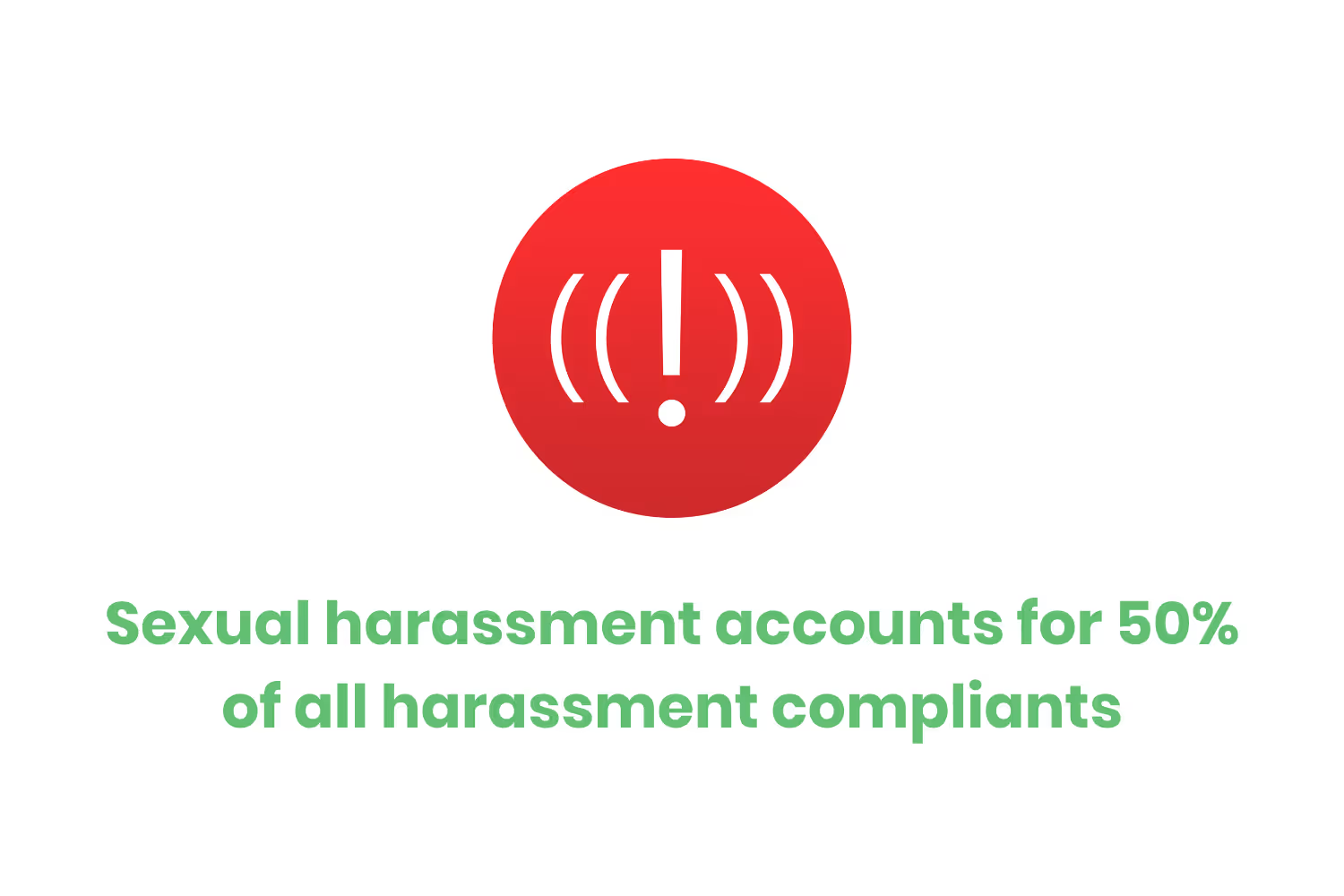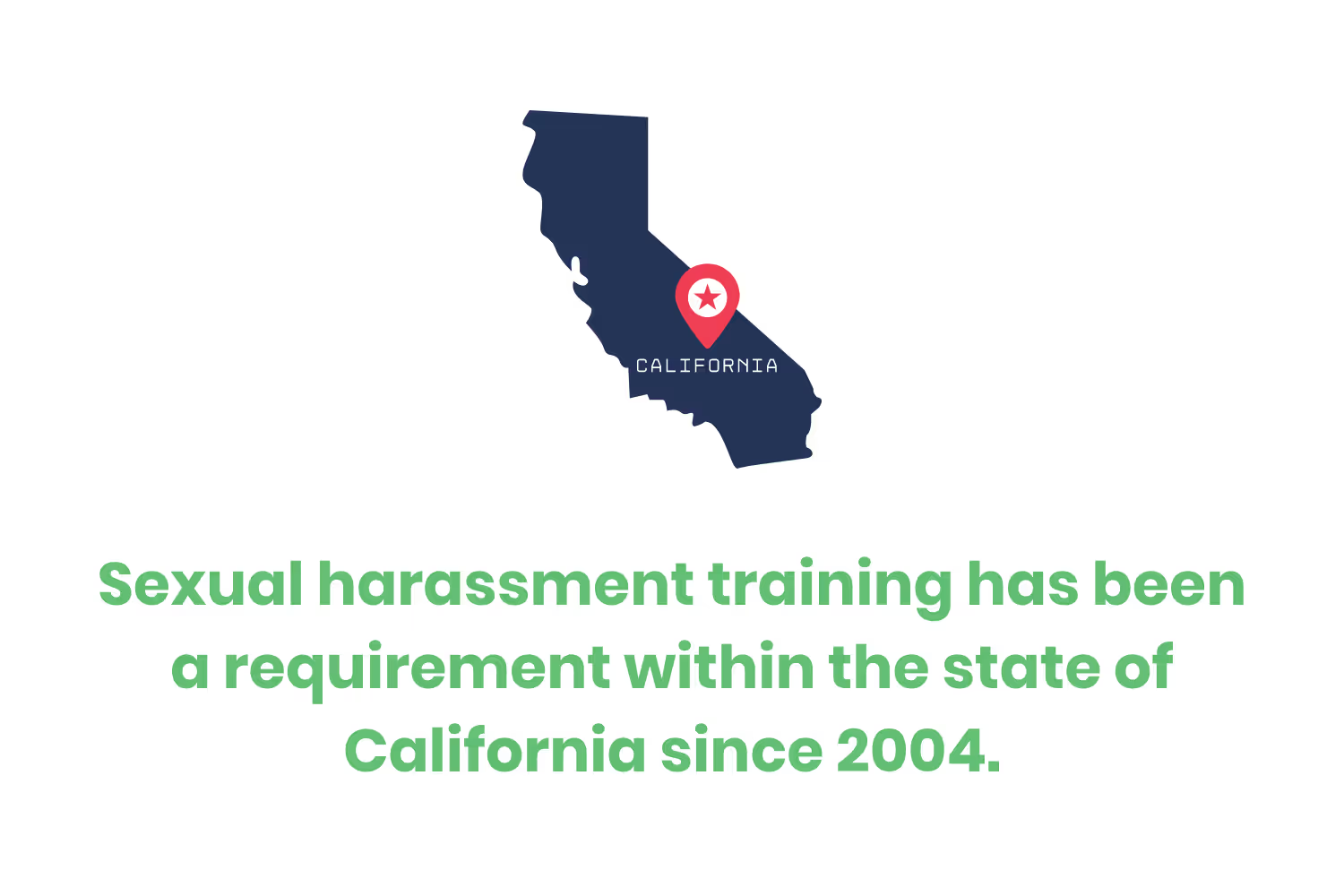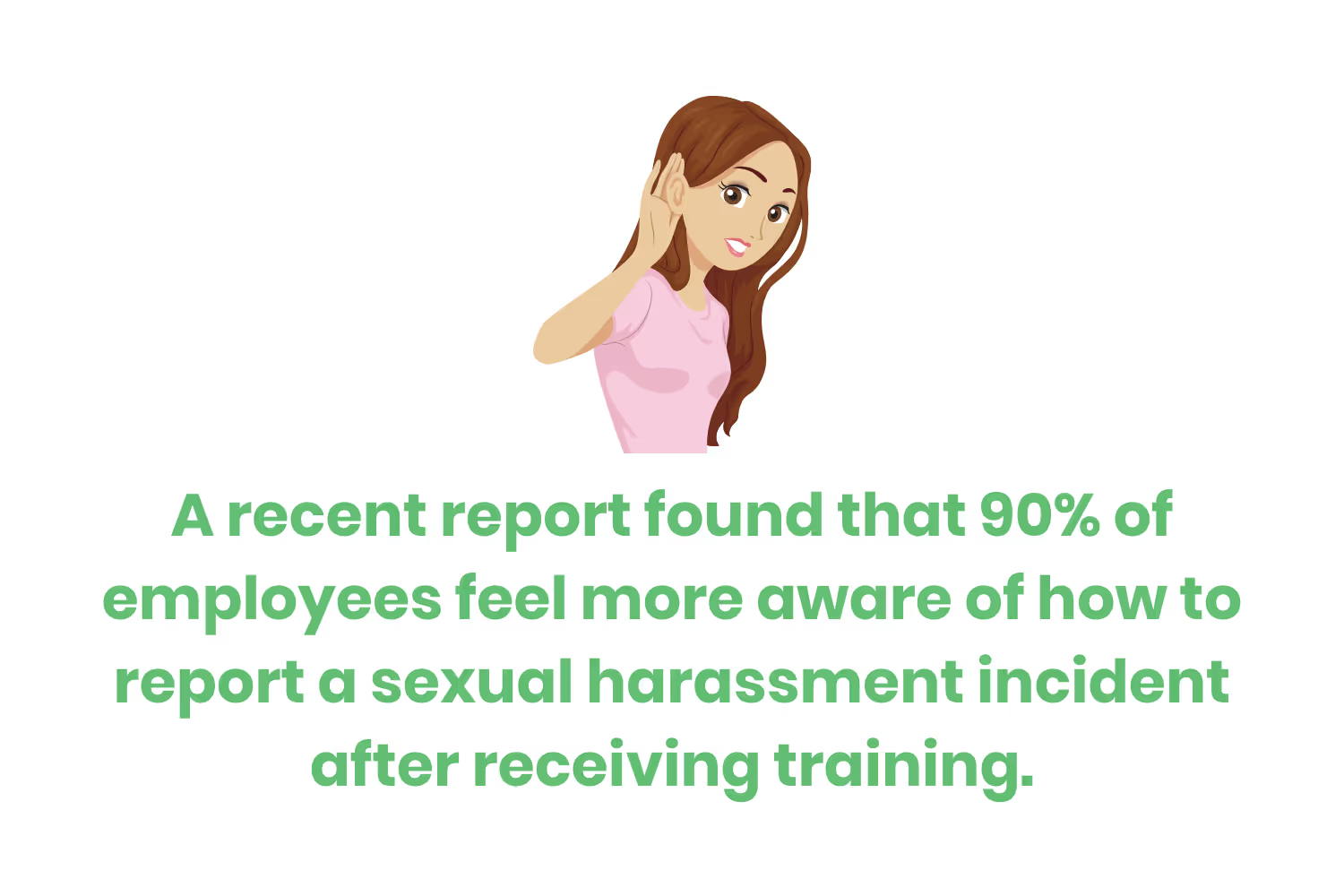The Guide to Sexual Harassment Training for Your Employees
At the time of writing, 22 states have some form of sexual harassment training requirement. The 32 (D.C. included) that don’t require it recommend it. In other words, if you don’t provide this type of training for your employees, you should strongly consider it. The only question then becomes, “How can you provide this?”

1 in 3 organizations doesn’t provide anti-harassment training to their employees.
On a small scale, that statistic might not sound as significant as it is. However, when you realize that there are more than 32.5 million businesses in the US, it suddenly seems more problematic.
In other words, 10.73 million businesses in the US don’t train their employees on anti-harassment.
That’s a big problem. Especially when you consider how common harassment occurs in the workplace.
Out of all the different types, though, sexual harassment is by far the most common type. It accounts for 50% of all complaints.

There are two main points that I’m trying to make with all of this. First, you need to make sure that you provide anti-harassment training to your employees. Second, the material you provide must include and cover sexual harassment as a topic.
You see, sexual harassment is so common that it’s what fueled the #MeToo social movement. Since then, many state legislatures now require that businesses provide sexual harassment training for their employees.
At the time of writing, 22 states have some form of sexual harassment training requirement. The 32 (D.C. included) that don’t require it recommend it.
In other words, if you don’t provide this type of training for your employees, you should strongly consider it. The only question then becomes, “How can you provide this?”
Know Your State’s Requirements
I alluded to this in the introduction of this blog post but the reality is that almost half of all states have a sexual harassment training requirement.
That makes things easy, right? Actually, not really.
You see, the reality is that each of those states has a different requirement in place for this type of training.
I’ll give you a few examples so that you can see what I mean.
Sexual harassment training has been a requirement within the state of California since 2004. The Golden State requires that organizations with 5 employees or more need to take this type of training for 1 hour every two years.

Kentucky does have a requirement in place, but it only applies to state officials.
Washington D.C. has a requirement in place specifically for tipped workers.
Meanwhile, Ohio doesn’t have any sort of requirement in place. But, Ohio Administrative Code states that “Prevention is the best tool for the elimination of sexual harassment.”
The point I’m trying to make with all of this is that different states have different requirements for sexual harassment. Thus, it’s important that the training you provide to your employees is compliant with the local government that you’re headquartered in.
That last statement holds true from content, administration and ongoing management perspectives concerning this training.
If what you provide to your team doesn’t align with where you’re located, you’re putting your organization at risk. Don’t get me wrong, implementing training is better than nothing. However, being out of compliance could result in a lawsuit.
Emphasize Through Engagement
After you’ve selected or added material for your sexual harassment training that’s following what your state requires, it’s time to send it to your team! Not so fast.
You see, one of the often-overlooked aspects of training is whether or not it’s engaging.
Many organizations view compliance training as a requirement that’s fulfilled by checking a box. As a result, they seek a “one size fits all” training that they can send en masse to their team.
Although that sounds easy, there’s a big problem with this approach and it requires a classroom comparison.

Harvard published a study that compared traditional classrooms to those that incorporated active learning and what they found was astonishing.
When you read the word “college lecture”, what comes to mind?
If you’re like me, you think of those giant, slanted rooms with swivel desks and cushioned seats. At the front of the room is the professor, who’s feverishly scratching on the chalkboard while droning on about the lesson in a monotone voice.
Not very exciting, right? What do you picture the majority of the students doing in the back of the room?
Sleeping.
Now, if you juxtapose this concept with training material that’s simply a Powerpoint presentation given to a team of professionals...are there any differences?
There probably isn’t anyone sleeping in the back of the meeting room, but some of them are still disengaged.
So, what’s the solution?
Harvard found that students who participate in classrooms that use relevant and engaging examples learn more than those that use traditional methods.
The point I’m trying to make with all of this is that the sexual harassment training that you provide to your employees needs to contain relevant examples and engaging material. The only real way to accomplish that is by utilizing proactive learning strategies.
Tie in Real-World Examples
After reading that last section, you’re probably wondering what I mean by using “relevant” examples.
The unfortunate reality is that sexual harassment is a common occurrence throughout the United States.
Since it happens so often, though, it provides a database of real-world examples to tie into your modules.
Remember how at the beginning of this blog post I mentioned the #MeToo movement? Yes, I’m giving myself a little bit of a pat on the back. However, tying in real-world examples related to the concepts that you’re trying to train your employees on works.
All that you have to do is a quick Google search, read a few articles and include the summaries of what you find in your training.

Don’t worry, though, I did that process for you already. Below are a few examples of real-world instances of sexual harassment in the workplace.
- On November 8, 2021, four employees at the San Bernardino County Public Defender’s Office filed a lawsuit alleging a culture of sexual harassment and misconduct. They claimed that upper management fueled a workplace atmosphere akin to that of the frat-boy movie, Animal House.
- Video game developer Activision Blizzard reached an $18 million settlement with the U.S. government in September of 2021. The settlement happened over sexual harassment and gender discrimination accusations that lead to a California lawsuit.
- An operating room technician sued Atlantic Health System in October of 2021. The lawsuit happened as the result of her management failing to take her reports of a “fraternity house atmosphere” into consideration. As a result, she was eventually harassed by coworkers.
These are just a few real-world examples of sexual harassment that occurred in the workplace. They each provide different stories that led to actual consequences, across different industries.
Providing similar examples in your training will help your team realize that it happens often and at any organization, regardless of what niche it serves.
Breakdown The Signs
7 in 10 women who experience sexual harassment while at work don’t report the incident.
You could say that the statistic above is the result of organizations not mandating proper internal training.
Although that’s probably true (especially if you cross-reference it to the statistic I gave you in the first sentence), that’s only part of the equation.
The reason why many sexual harassment instances go unreported may be because of a content issue.
98% of organizations had policies in place for reporting this form of provocation in 2016. Most policies include definitions and remediation steps if an incident occurs.
However, I’m not proposing that that’s the gap. Instead, maybe it’s a matter of employees not knowing the signs of sexual harassment and how to report it.

Being the victim of an inappropriate act in a professional atmosphere takes a large psychological toll. It’s not fair to place all of the responsibility for reporting on the victim.
Thus, you need to spread out that responsibility to your entire team by teaching them to signs of sexual harassment.
A recent report found that 90% of employees feel more aware of how to report a sexual harassment incident after receiving training.
That might seem like an obvious statistic. If you trained your team on how to make a peanut butter and jelly sandwich they would likely have greater awareness in making one afterward. The same study found that over 60% of men and women employees say that they would file an internal report if they experienced sexual misconduct.
Providing your workforce training over this unfortunately common occurrence is a step in the right direction. Yet, if it doesn’t go over the common signs, how to report it and your organization’s policies, you’re making it hard for potential victims.
Conclusion
We live in the unfortunate reality where sexual harassment in the workplace happens often, the statistics I provided throughout are proof of that. Although some might think it’s easier to turn a blind eye, that’s not acceptable.
As it stands today, less than one-third of those who witness this type of conduct report it.
The only way to combat these grim statistics is by implementing a comprehensive sexual harassment training program. It needs to provide your team with the tools necessary to spot, stop and report any misconduct while staying in compliance with what’s required by your organization’s state.
Although it’s not an easy task, its benefits outweigh what’s required from an effort standpoint, especially if it’s required by your state.
Emphasize your product's unique features or benefits to differentiate it from competitors
In nec dictum adipiscing pharetra enim etiam scelerisque dolor purus ipsum egestas cursus vulputate arcu egestas ut eu sed mollis consectetur mattis pharetra curabitur et maecenas in mattis fames consectetur ipsum quis risus mauris aliquam ornare nisl purus at ipsum nulla accumsan consectetur vestibulum suspendisse aliquam condimentum scelerisque lacinia pellentesque vestibulum condimentum turpis ligula pharetra dictum sapien facilisis sapien at sagittis et cursus congue.
- Pharetra curabitur et maecenas in mattis fames consectetur ipsum quis risus.
- Justo urna nisi auctor consequat consectetur dolor lectus blandit.
- Eget egestas volutpat lacinia vestibulum vitae mattis hendrerit.
- Ornare elit odio tellus orci bibendum dictum id sem congue enim amet diam.
Incorporate statistics or specific numbers to highlight the effectiveness or popularity of your offering
Convallis pellentesque ullamcorper sapien sed tristique fermentum proin amet quam tincidunt feugiat vitae neque quisque odio ut pellentesque ac mauris eget lectus. Pretium arcu turpis lacus sapien sit at eu sapien duis magna nunc nibh nam non ut nibh ultrices ultrices elementum egestas enim nisl sed cursus pellentesque sit dignissim enim euismod sit et convallis sed pelis viverra quam at nisl sit pharetra enim nisl nec vestibulum posuere in volutpat sed blandit neque risus.

Use time-sensitive language to encourage immediate action, such as "Limited Time Offer
Feugiat vitae neque quisque odio ut pellentesque ac mauris eget lectus. Pretium arcu turpis lacus sapien sit at eu sapien duis magna nunc nibh nam non ut nibh ultrices ultrices elementum egestas enim nisl sed cursus pellentesque sit dignissim enim euismod sit et convallis sed pelis viverra quam at nisl sit pharetra enim nisl nec vestibulum posuere in volutpat sed blandit neque risus.
- Pharetra curabitur et maecenas in mattis fames consectetur ipsum quis risus.
- Justo urna nisi auctor consequat consectetur dolor lectus blandit.
- Eget egestas volutpat lacinia vestibulum vitae mattis hendrerit.
- Ornare elit odio tellus orci bibendum dictum id sem congue enim amet diam.
Address customer pain points directly by showing how your product solves their problems
Feugiat vitae neque quisque odio ut pellentesque ac mauris eget lectus. Pretium arcu turpis lacus sapien sit at eu sapien duis magna nunc nibh nam non ut nibh ultrices ultrices elementum egestas enim nisl sed cursus pellentesque sit dignissim enim euismod sit et convallis sed pelis viverra quam at nisl sit pharetra enim nisl nec vestibulum posuere in volutpat sed blandit neque risus.
Vel etiam vel amet aenean eget in habitasse nunc duis tellus sem turpis risus aliquam ac volutpat tellus eu faucibus ullamcorper.
Tailor titles to your ideal customer segment using phrases like "Designed for Busy Professionals
Sed pretium id nibh id sit felis vitae volutpat volutpat adipiscing at sodales neque lectus mi phasellus commodo at elit suspendisse ornare faucibus lectus purus viverra in nec aliquet commodo et sed sed nisi tempor mi pellentesque arcu viverra pretium duis enim vulputate dignissim etiam ultrices vitae neque urna proin nibh diam turpis augue lacus.




